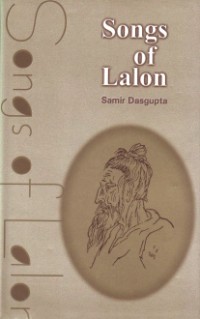Book Review
Songs of Lalon
How the Nameless
Bird Enters the Cage
Audity Falguni
 Baul is a mystic-group cult, which flourished on the soil of Bengal during the early process of Hindu-Buddhist-Islamic synergy. Its root may be traced back through time even to the pre-Vedic Tantric cults. Lalon (1774-1890), the great exponent of Baul philosophy, belonged to the mainstream of the original Baul cult and added a critical social dimension to the already spreading subaltern stream of consciousness. His songs inspired Rabindranath Tagore to 'plunge into the river of beatitudes.' Baul is a mystic-group cult, which flourished on the soil of Bengal during the early process of Hindu-Buddhist-Islamic synergy. Its root may be traced back through time even to the pre-Vedic Tantric cults. Lalon (1774-1890), the great exponent of Baul philosophy, belonged to the mainstream of the original Baul cult and added a critical social dimension to the already spreading subaltern stream of consciousness. His songs inspired Rabindranath Tagore to 'plunge into the river of beatitudes.'
Unfortunately, Lalon's songs are yet to be translated in its full volume. Songs of Lalon by Samir Dasgupta presents a slim collection of English translations of 34 prominent compositions by Lalon along with the original text and an authentic introduction. The followers of Lalon in Bengal are free from all kinds of earthly temptation and social bondage. They are forbidden to accumulate private property and reproduce children. Male bauls have their sadhan sangini or female companion without having recourse to any formal rituals of marriage and they vow not to reproduce child. They beg in the day and return to their akhra (place where people assemble for religious discussion and worship) by evening. They quest for spiritual splendor through composing mystic lyrics and adding tunes to it.
The author Samir Dasgupta informs us in the introduction of the book Songs of Lalon that there already exists a recommendable amount of literature on the life and work of Lalon Fakir, which is mainly anecdotal in nature and virtually unverifiable at this distant point of time. An obituary article, appearing barely a fortnight after Lalon's death in the long-defunct Bengali journal Hitokari, in its edition of October 31, 1890 should be of particular interest. This unsigned article, titled Mahatma Lalon Fakir, tells us that at the time of his death Lalon Fakir was a familiar name, not only in and around his akhra, set up in 1823 at Chheuria, Kushtia. His disciples, numbering around 10,000, were scattered over places like Chittagong, Rangpur and Jessore. At the akhra, Lalon used to live with his wife Bishakha Fakirani whom he married after his devoted first wife was disallowed by Hindu zealots to join her husband following his conversion to Islam. In deference to the strictures of his newfound faith, Lalon didn't have any children by his second wife either. As the legend goes, Lalon was born of Hindu Kayastha parents and during a pilgrimage to Murshidabad with other Bauls of his native village, he contracted a virulent type of small pox and was abandoned by his companions in a precarious condition on the banks of the Ganges. A Muslim man of the weaver community, Malam Shah, and his wife Matijan took him to their home and nursed him back to life. At their home, Lalon met Siraj Sain, a Muslim rural philosopher -cum-Baul whom later Lalon mentioned in a number of his songs. The trauma of being abandoned by his own community and conversion to a new faith helped Lalon in attaining a very wide outlook on the question of religion. Asked about his religion, Lalon never answered directly and instead used to sing the following song:
They are curious to know what Lalon's faith is,
Says Lalon: The shape of religion eludes my vision.
Circumcision tells a Muslim from others,
But what is the mark of his woman?
The Brahman is known by his thread,
How do I tell who is a Brahmani?
Lalon's akhra was situated in the zamindari estate of Rabindranath Tagore and a local postman named Gagan (1840-1910), a direct disciple of Lalon, is believed to have been the poet's primary source of collection of Lalon's songs- songs that profoundly influenced his spiritual-philosophical ideas and were seminal to his finest poetic imagery. Some of the Lalon's best known lyrics such as Moner manush moner madhye koro anweshan, Amar e ghar khanay ke biraj kare and Khanchar bhitor achin pakhi komne ashe jay might have contributed largely in shaping Tagore's mystic philosophy and secular humanism. The last poem, incidentally, is alluded to in various writings of Tagore, including his celebrated epic-novel Gora (1910). In Dasgupta's translation, this widely acclaimed song reads:
Tell me how the nameless bird
Enters the cage,
Flies away…
If only I could catch it once,
I would
Throw my mind's chain around its feet.
This house has eight chambers with nine doors,
There are lattices on the walls,
And a Hall of mirrors at the top.
According to Dasgupta, the ever-intriguing phenomenon of the menstrual cycle and the seminal fluid (the archetypal water of creation' in Tantric-Baul lingo), and the five elements of the universe, including the human body imagined to be the abode of the Atma or the soul (achin pakhi or the nameless bird), are supposed to make for the ultimate communion with the Paramatma (Supreme Being). These constitute the cardinal features of Dehatatwa, the means to attain salvation through cultivation of the body. Tagore, a man of puritan Victorian learning, however, avoided the portion of cultivation of the body or Dehatatwa in his own adoption of Baul philosophy. Songs of Lalon would be a good hand out for the researchers.
Copyright
(R) thedailystar.net 2009 |
